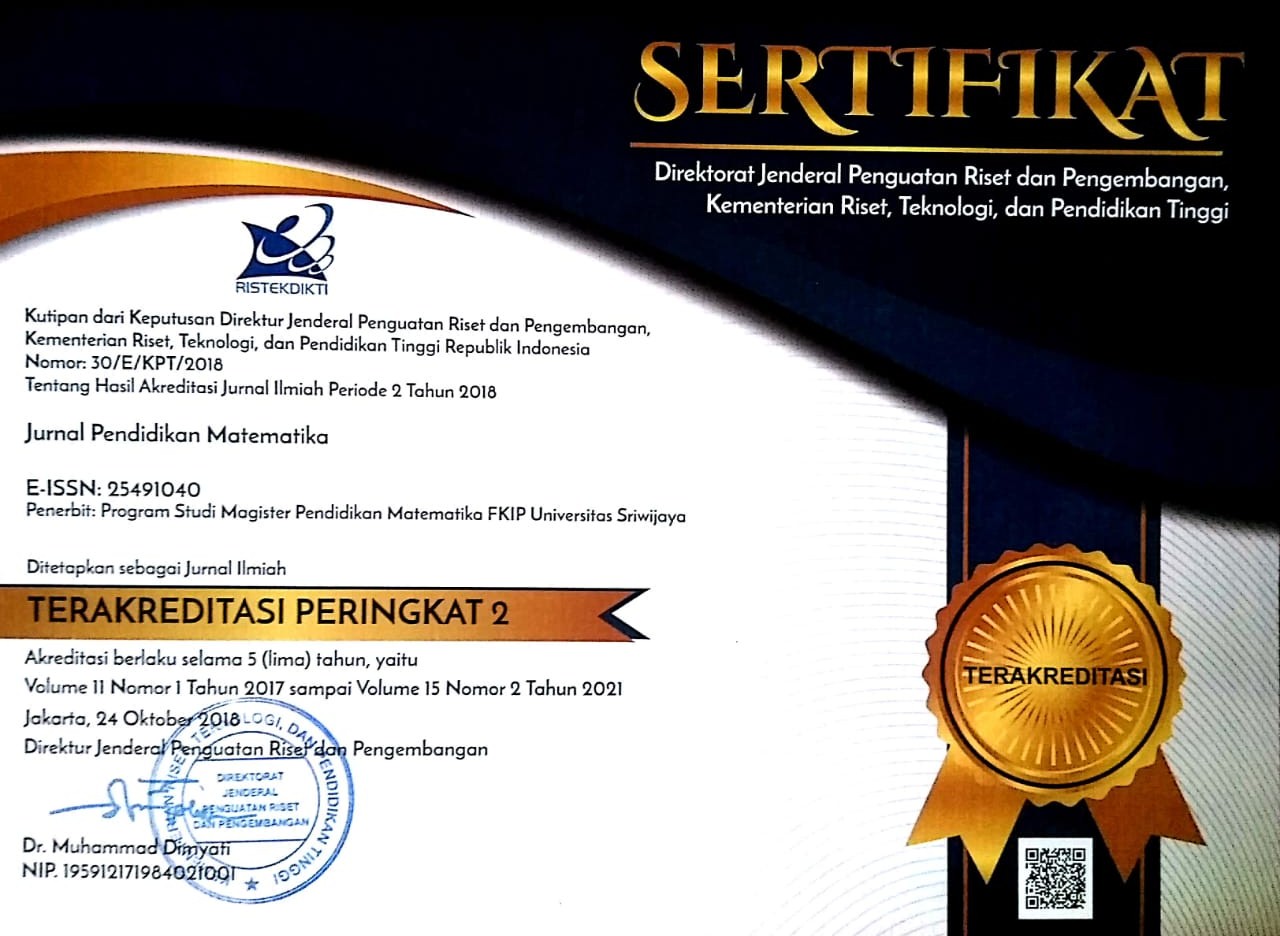Students’ Obstacles in Learning Sequence and Series Using Onto-Semiotic Approach
Abstract
Keywords
Full Text:
PDFReferences
Amin, M. E. I. A., Juniati, D., & Sulaiman, R. (2018). Onto semiotic approach to analyze students’ understanding of algebra based on math ability. AIP Conference Proceedings. https://doi.org/10.1063/1.5054481.
Ardika, Y., & Sardjana, A. (2016). The effectiveness of the mnemonic method in terms of students memory and mathematics learning outcomes at vocational high school grade X [in Bahasa]. Kreano, Jurnal Matematika Kreatif-Inovatif, 7(1), 66–73. https://doi.org/http://dx.doi.org/10.15294/kreano.v7i1.5006.
Brigham, F., & Brigham, M. (2001). Current practice alerts of the council for exceptional children. (5).
Brousseau, G. (2002). Theory of didactical situations in mathematics. In Kluwer Academic Publisher. https://doi.org/10.1007/0-306-47211-2
Creswell, J. W. (2013). Qualitative inquiry and research design: Choosing among five approaches (3rd ed.). SAGE Publications , Inc.
Dewi, D. A. K., Suryadi, D., & Sumiaty, E. (2016). Backward thinking in planning didactical design of circle tangent concept [in Bahasa]. In D. Suryadi, E. Mulyana, T. Suratno, D. A. K. Dewi, & S. Y. Mudy (Eds.), Monograf Didactical Design Research (pp. 12–24). Bandung: Bandung: Rizqi Press.
Fauzia, T. A., Juandi, D., & Purniati, T. (2017). Didactical design on learning arithmetic sequences and series concepts in high school level [in Bahasa]. Journal of Mathematics Education Research, 1(1), 1–10.
Firdaus, Kailani, I., Bakar, M. N. Bin, & Bakry. (2015). Developing critical thinking skills of students in mathematics learning. Journal of Education and Learning, 9(3), 226–236.
Font, V., Godino, J. D., & D ’amore, B. (2007). An onto-semiotic approach to representations in mathematics education. For the Learning of Mathematics.
Godino, J. D., Batanero, C., & Roa, R. (2005). An onto-semiotic analysis of combinatorial problems and the solving processes by university students. Educational Studies in Mathematics. https://doi.org/10.1007/s10649-005-5893-3.
Godino, J. D., Rivas, H., Burgos, M., & Wilhelmi, M. R. (2018). Analysis of didactical trajectories in teaching and learning mathematics: overcoming extreme objectivist and constructivist positions. International Electronic Journal of Mathematics Education. https://doi.org/10.12973/iejme/3983.
Graybeal, C. D., & Strickland, T. K. (2018). The trouble with kissing and other mnemonic devices. Ohio Journal of School Mathematics, 11–17.
Hardiyanti, A. (2016). Analysis of students' difficulties in solving mathematics problems on sequences and series topics [in Bahasa]. Proceedings of the National Conference on Mathematics Research and Its Learning (KNPMP I), 2(2), 78–88.
Harijani, D. S., Muhsetyo, G., & Susanto, H. (2016). High school students' difficulties in solving sequences and series open-ended problems [in Bahasa]. (August), 228–236.
Miller, S. P., & Mercer, C. D. (1993). Mnemonics : Enhancing the math performance of students with learning difficulties. Intervention in School And Clinic, 29(2), 78–82.
Montiel, M., Wilhelmi, M. R., Vidakovic, D., & Elstak, I. (2009). Using the onto-semiotic approach to identify and analyze mathematical meaning when transiting between different coordinate systems in a multivariate context. Educational Studies in Mathematics. https://doi.org/10.1007/s10649-009-9184-2.
Mutodi, P., & Mosimege, M. (2016). Exploring grade 12 learners’ operation sense in sequences and series. In B. Goba & J. Naidoo (Eds.), Proceedings of the 22 nd Annual National Congress of the Association for Mathematics Education of South Africa (Vol. 1, pp. 347–363).
Octriana, I., Putri, R. I. I., & Nurjannah, N. (2019). Students' mathematical reasoning in learning number patterns using PMRI and LSLC [in Bahasa]. Jurnal Pendidikan Matematika, 13(2), 131–142.
Oktopiani, R. (2017). Didactical design of arithmetic sequences and series topics to develop mathematical reasoning for secondary school students grade IX [in Bahasa]. Unpublished Thesis. Bandung: Indonesia University of Education (UPI).
Regulation of the Minister of Education and Culture No. 37 of 2018 concerning Core Competencies and Basic Competencies of Lessons in the 2013 Curriculum in Basic Education and Secondary Education [in Bahasa]. (2018). Jakarta: Kemendikbud.
Rudi, R., Suryadi, D., & Rosjanuardi, R. (2020). Identifying students’ difficulties in understanding and applying pythagorean theorem with an onto-semiotic approach. MaPan : Jurnal Matematika dan Pembelajaran, 8(1), 1–18.
Septiahani, A., Melisari, M., & Zanthy, L. S. (2020). Analysis of vocational high school students error in solving sequences and series problems [in Bahasa]. Mosharafa : Jurnal Pendidikan Matematika, 9(2), 311–322.
Sumargiyani, & Hibatallah, M. I. (2018). Analysis of students' problem-solving ability on the topic of sequences and series at ali maksum high school grade XI [in Bahasa]. Proceedings of the National Seminar on Ethnomatnesia Mathematics Education, 891–900.
Suryadi, D. (2010). Creating an active learning process: a study from the viewpoint of learning theory and didactical theory [in Bahasa]. Paper Presented at the National Seminar on Mathematics Education at Padang State University (UNP), 1–16.
Suryadi, D. (2019a). Ontology and epistemology in Didactical Design Research (DDR) [in Bahasa]. In Philosophical Foundations of Didactical Design Research (DDR) (pp. 18–42). Bandung: Gapura Press.
Suryadi, D. (2019b). Basic theory of Didactic Design Research (DDR) [in Bahasa]. In Didactic Design Research and Its Implementation (pp. 7–33). Bandung: Gapura Press.
Verdianingsih, E. (2020). Mnemonic strategy in learning mathematics [in Bahasa]. EDUSCOPE, 06(01), 78–85.
Wahyuningrum, A. S., Suryadi, D., & Turmudi, T. (2019). Learning obstacles among indonesian eighth graders on ratio and proportion learning obstacles among Indonesian eighth graders on ratio and proportion. IOP Conf. Series: Journal of Physics: Conf. Series, 1–8. https://doi.org/10.1088/1742-6596/1320/1/012046.
Wibowo, E. (2018). Analysis of students' mathematics learning difficulties in solving geometric sequences and series problems at Luwuk Vocational high school grade XII [in Bahasa]. JURNAL LINEAR, 02(4), 1–6.
Zebua, V. (2020). Analysis of student errors in solving sequences and series problems in terms of mathematical conceptual-understanding [in Bahasa]. Jurnal LEMMA, 6(2), 122–133. https://doi.org/10.22202/jl.2020.v6i2.4088.
DOI: https://doi.org/10.22342/jpm.15.2.13519.115-132
Jl. Srijaya Negara, Bukit Besar
Palembang - 30139 Indonesia
Jurnal Pendidikan Matematika is licensed under a Creative Commons Attribution-NonCommercial-ShareAlike 4.0 International License.
Indexed in:


